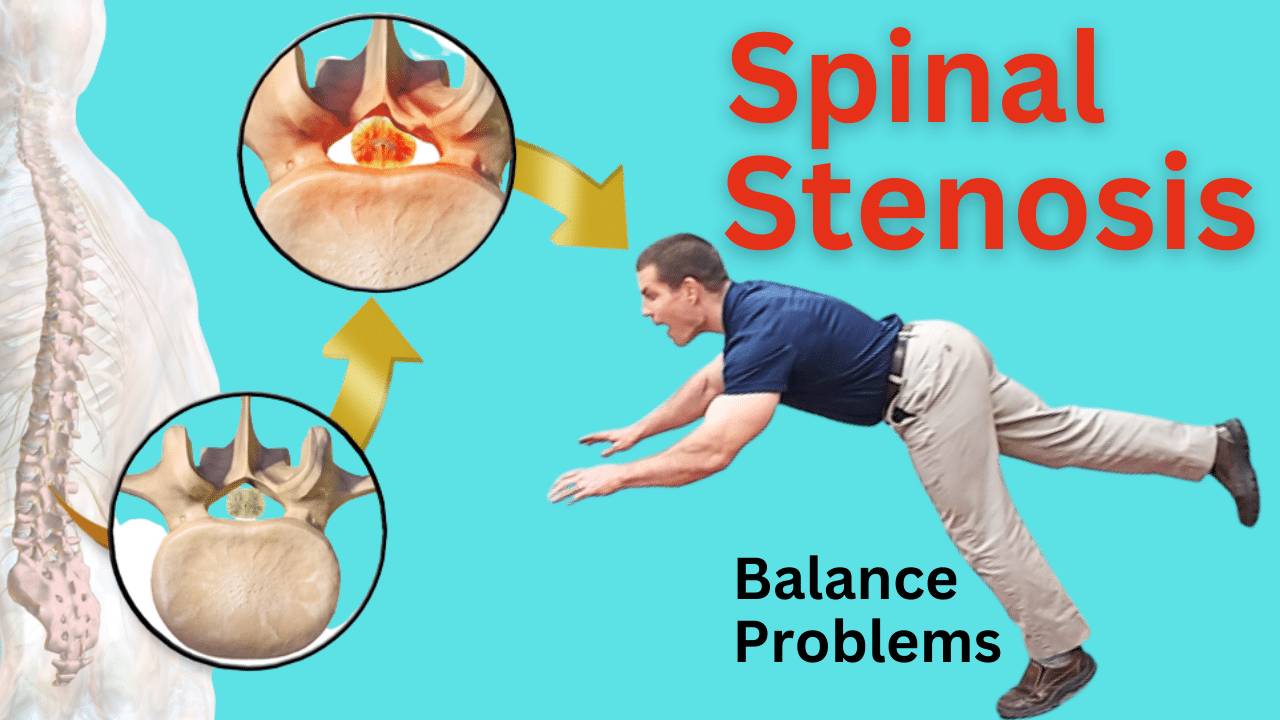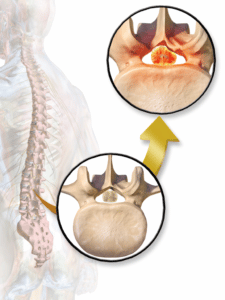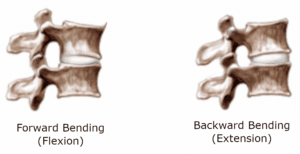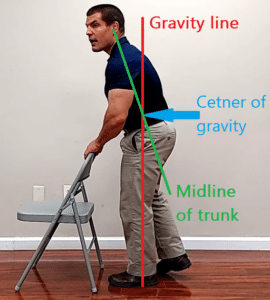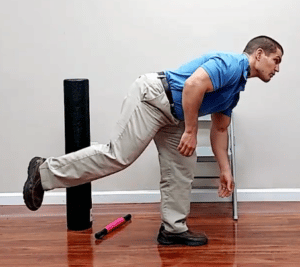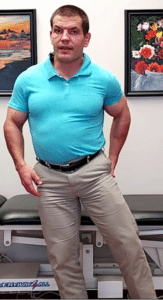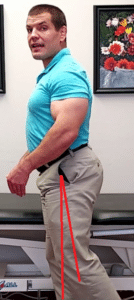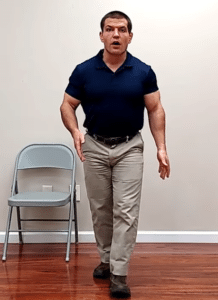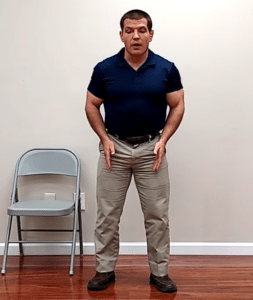Spinal stenosis and balance problems often go hand in hand. However, sometimes patients and medical providers alike don't link the cause and effect relationship between the two.
Watch the video to learn how to help balance problems from spinal stenosis.

Table of Contents
- Does Spinal Stenosis Affect Balance?
- Three Sensory Systems Affect Your Balance
- How Does Spinal Stenosis Cause Balance Problems?
- Treatment For Balance Problems From Spinal Stenosis
- Best Balance Exercise For Spinal Stenosis
- Tip #1 To Improve Balance When Walking
- Tip #2 To Improve Balance When Walking
- Conclusion
Does Spinal Stenosis Affect Balance?
Spinal stenosis and balance problems often go hand in hand.
When I see patients for spinal stenosis, I find out that a lot of them have balance problems or have fallen.
When I see patients with a primary complaint of unsteady balance or falls, I discover that many of them have spinal stenosis.
However, often they don't link the two together, and neither does their medical team.
But spinal stenosis and balance problems can often have a cause-and-effect relationship.
Before we get started, you have to understand a little bit more about the systems in your body that help you maintain your balance.
Three Sensory Systems Affect Your Balance
There are three sensory systems that help you understand where your body is in space:
- Your inner ear
- Your visual system
- Your somatosensory system
They send information to your brain.
Your brain then processes that information and sends out a motor response to your muscles telling them how to react to maintain your center of gravity over your feet.
The Inner Ear
First, let's discuss the inner ear.
Your inner ear has three sets of semicircular canals on either side, which are oriented in three different planes.
They send information to your brain, telling you where you are in space.
If one of the crystals in the ear gets dislodged, it can send misleading information to your brain, causing vertigo.
However, when people complain of balance problems or dizziness, it doesn't always mean they have vertigo.
It can lead clinicians on a search for different causes of inner ear dysfunction when that might not be the case.
The Visual System
The second system that sends information to your brain is your eyes.
Visual information helps us understand our position relative to our surroundings.
If we see changes in the scenery with respect to stationary objects, our brain interprets it as movement.
We heavily rely on our visual system for balance.
Closing your eyes while maintaining balance or standing on one foot becomes more challenging because we rely heavily on our visual system.
The Somatosensory System
The third system involved in balance is our somatosensory system, which includes the skin, receptors on the bottoms of our feet, and the receptors in our joints.
For example, individuals with diabetic neuropathy who can't feel their feet well often experience balance problems.
The receptors in the joints, ligaments, ankles, knees, and hips provide feedback on tension and body position. Joint replacements may disrupt these receptors, thus affecting balance.
The Motor Response
Your brain has to process all of this sensory information from the feet, eyes, and inner ears.
Your brain then sends signals down the spinal cord to the muscles in your trunk and lower limbs.
Spinal stenosis interrupts this flow of information.
How Does Spinal Stenosis Cause Balance Problems?
Spinal stenosis is a narrowing around the spinal cord or peripheral nerves.
Spinal stenosis impairs the transmission of sensory information from the legs to the brain.
It also hinders the motor response, preventing the brain from effectively communicating with the muscles involved in balance.
In spinal stenosis cases involving the L4, L5, and S1 nerve roots, issues like foot drop and weakened hip muscles can arise.
This weakness can in turn affect your balance or cause you to trip over your feet.
Treatment For Balance Problems From Spinal Stenosis
To address balance problems caused by spinal stenosis, first and foremost, you want to address the root cause of the problem by treating the spinal stenosis itself.
You can do balance exercises all day long, but if the nerve roots are being pinched and your muscles aren't getting the signal telling them to contract, it doesn't matter how many balance exercises you do.
Your muscles just aren't going to get stronger.
You can refer to this post for information on what to do for spinal stenosis.
On extremely important thing to do though is to decrease the arch in your lower back.
Excessive back arch (extension) narrows spaces where the nerves to your legs exit the spine, as shown below.
Flattening the back (flexion) allows for better signal transmission from the legs to the brain and vice versa.
Maintaining a pelvic tilt and a more neutral spine position while standing can be beneficial.
When you're walking, you want to lean forward just slightly to help keep your spine in a more neutral position.
Additionally, when you're doing balance exercises, you also want to maintain the same spinal neutral position where you have your back a little bit flatter.
Best Balance Exercise For Spinal Stenosis
One of my favorite balance exercises both for people with and without spinal stenosis is simply just balancing on one leg.
The reason for that is most falls don't happen when you have two feet planted on the ground.
Falls usually happen when you're on one foot. For example, taking a step when walking or when going down stairs.
Therefore, standing on one leg is a really good place for most people to start.
If you have spinal stenosis or balance problems, make sure to hold on to something sturdy when practicing balancing on one leg. Examples include a heavy chair, the kitchen counter, a table, or the back of the couch.
Again, you don't want to allow a big arch in your back when you're practicing your balance because you're not getting the full motor signal down to your legs.
So tuck your pelvis underneath of you to get your body a little bit rounded out. Then pick one leg up off the ground, with your spine a little bit rounded.
Variations of the Single Leg Balance Exercise
You can do this exercise either with your leg in front of you or with your leg behind you.
However, the way shown above more functionally simulates the position you're in when you're loading weight onto your leg when walking.
It also kind of helps counterbalance you.
If you're leaning your trunk forward and putting your leg behind you, it maintains part of your body in front of your foot and part of your body behind your foot.
That helps to keep your center of gravity directly over your base of support (foot).
It's kind of a mini-version of the golfer's bend exercise.
When you get really good at balancing on one leg, then you can move to more advanced versions. Examples include the golfer's bend (shown above), or doing leg kicks to the front, back, and side.
But until you get really good at balancing on one leg, don't move on to the advanced versions. Standing on one leg is probably all you need to start out.
Tip #1 To Improve Balance When Walking
There are some tips to use when you're walking to actually help you improve your balance while you're walking.
The first tip is just taking smaller steps.
If you take really long steps, you have to maintain your balance on one leg longer.
Additionally, when you take really long steps, if you've got stiffness in your hip flexor muscles, that will pull you into spinal extension and can cause back or leg pain or cause weakness in your legs. You may feel like you can't walk as long or that you tire out and have to sit down.
Therefore, taking shorter steps is a good idea so that you don't have to maintain your balance on one foot for as long.
Additionally, when you take short steps helps you to keep a little forward trunk lean. That helps open up the nerve spaces in your lower back, and it'll allow you to walk longer before you feel like you need to stop.
So that's the first tip to help you walk with better balance if you have spinal stenosis.
Tip #2 To Improve Balance When Walking
The second tip is to keep your feet a little bit wider apart.
I see a lot of patients who walk almost like they're walking on a tightrope, where their legs will come close to midline or even sometimes cross midline.
Walking like this can put you at risk for get your legs crossed and tripping.
Conversely, when you keep your feet a wider when walking, it gives you a wider base of support
The wider of a base of support you have, the more side-to-side stability you have.
If you have your feet really close together, then it doesn't take a lot of perturbation to knock your center of gravity outside of your base of support. When your center of gravity goes outside your base of support, that's what can cause you to fall.
DMI Sports Walking Cane and Stick for Ad...
$22.76 (as of July 26, 2024 03:25 GMT -05:00 - More infoProduct prices and availability are accurate as of the date/time indicated and are subject to change. Any price and availability information displayed on [relevant Amazon Site(s), as applicable] at the time of purchase will apply to the purchase of this product.)Using a cane can even further widen your base of support if you have balance problems from spinal stenosis.
Conclusion
So those were the tips to help you if you do have a balance problem and you do have spinal stenosis, and you think they may be related
Just to kind of review and summarize, the tips were:
Doing a standing balance exercise, holding on to something, tilting your pelvis, and leaning forward slightly with your trunk while putting your leg behind you. Then you can slowly let up on how much help you're using with your hand as your balance allows.
Lean slightly forward and take smaller steps when walking.
Keep your feet wider apart to give you more side-to-side stability when walking.
Need Help For Spinal Stenosis and Balance Problems?
If you live in the St. Louis area and need help for spinal stenosis and balance problems, tap the button below to request an appointment with one of our specialist physical therapists.
Like this post? Check out some of our other post about exercises for lower back pain
Lean Forward When Walking? 3 Exercises to Stop Walking Hunched Over
8 Stretches For Lower Back Pain and Hip Mobility
7 Exercises For Arthritis In Lower Back
The 7 Best Core Strengthening Exercises For Lower Back Pain
Yoga Poses For Lower And Upper Back Pain
Chair Yoga Seniors Can Do For Neck Pain & Back Pain In 7 Easy Poses
3 Best Balance Exercises For Seniors To Improve Balance At Home

